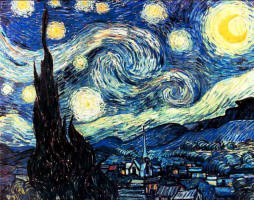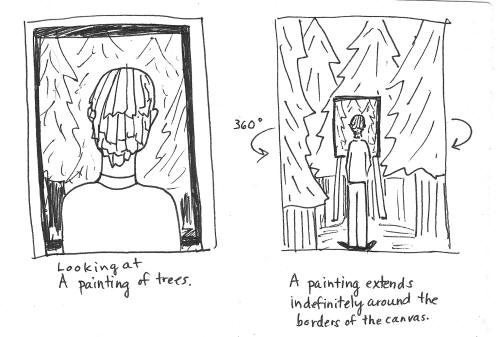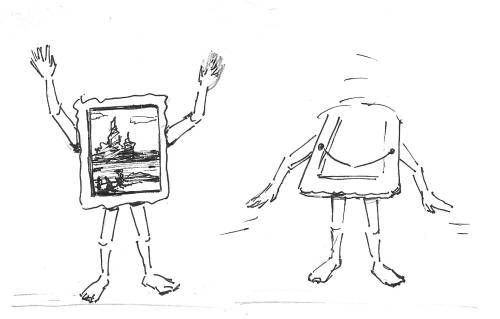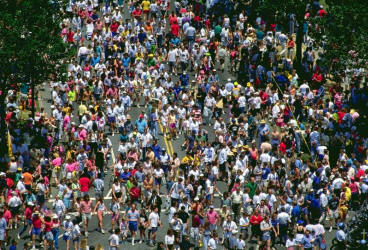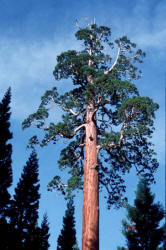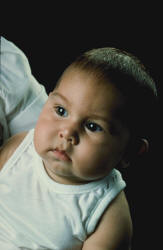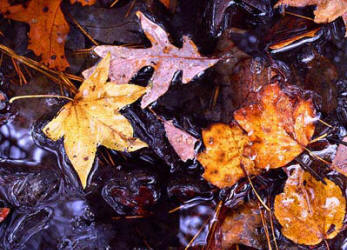|
1. Painting, as the limiting case of literary narration
The literary narrator can take as long as he wants to describe a specific event. If we allow this time to grow without limit and allow the duration in which the event occurred to shrink, we end up with a perpetual narration of a single moment in time. If this narration is in visual form, we have a painting, or at least one that represents an event.
2. Two different spaces
As with film, the space of a painting is physically impenetrable. If we try to touch it, the reality it contains vanishes and turns into something else: pigment. If we try to see more of it, or see it from a different angle, we find that its appearance remains unchanged. We are in two different spaces.
3. The frame
The frame of the picture mediates between these two spaces. It is not however a boundary between the two, because neither space seems to terminate anywhere. The painting space, if the work is representational, has an implied continuation below and above the frame, to its left and right.
It also seems to continue indefinitely away from us and towards us. It is only if we turn, or look in a different direction, to confirm the extension, that it is contradicted, but then the entire artistic space itself disappears,
and the point is moot. The everyday space, in its turn, seems to include as part of itself the portion of the wall occupied by the painting, the canvas and the paint.
Thus both spaces seem to go on indefinitely, neither interfering with the other, with no single point being common to both.
4. The full expression of a form
Freed from time and causality, a represented object can exhibit properties that would be impossible in the everyday reality. A tree in a dense forest cannot extend its branches as it would growing alone in an arboretum;
the form inherent in its DNA is never realized .
However, no matter how cluttered the painting space may be, the painter can reveal any aspects of an object’s inherent form.
5. With time under the control of space, different times can exist within the same space
Space in painting is not closely tied to any one particular time; a single time does not extend cohesively throughout the work’s space. For instance, different portions of a painting may represent different events or stages in the life of a common subject. Even in a single portion of space, one object can manifest simultaneously the properties of different stages in its normal evolution.
6. Another way in which space now controls time.
The dominance of space over time shows up in photography’s ability to reveal to us spatial forms normally hidden to us in everyday time, such as a moment from the path of a bullet or several hours of the diurnal motion of the stars in the sky. The resulting trails of the stars is purely spatial, giving no information about how the trail was created through time: at what rate, in what direction, etc.. Once a painter has been made aware of something through a photograph, he is free to depict the same thing.
7. Ideated sensations allow us to enter the work’s space
The only data arriving directly to our senses from the painting comes through sight. Although sight excludes us from the artistic space, ideated sensations of touch, smell or hearing, that are stimulated by what we see, allow us to perceive that space as if we were in its midst.
8. Photography considered separately from painting
Relations between time and space in photography are dealt with, such as the correlation of exposure time to content. Black represents the limiting case in minimum exposure time. Both our retina and photographic film require at least a minimum exposure time. Otherwise time would disappear and both would be black. For consciousness, though, black is a color rather than an absence of sensation. As exposure time is increased absence cedes to presence, presence becomes color, color becomes shape, and shape becomes object. When photographing an object in motion, as exposure time increases, the static trail of the motion eventually prevails over the identity of the object in motion.
9. Differences between painting and photography
Photography and painting occupy the same position on the spectrum because there are no salient differences between them in how we experience time and space. There are however interesting differences during the creation phase. A photograph captures a scene all at once and is then developed over a period of time and in the dark. A painting starts out “invisible”, in the light, is developed gradually, but remains visible the entire time. Any effect that is achievable by painting is achievable by photography, and vice versa. For instance, multiple exposure is more easily achieved in photography but the appearance it creates is equally representable by the painter.
"Download full text of chapter"
|
